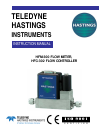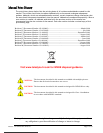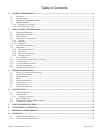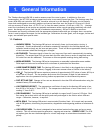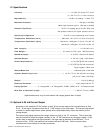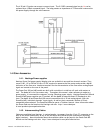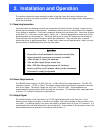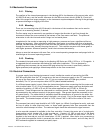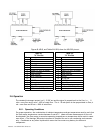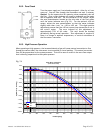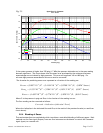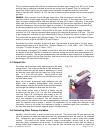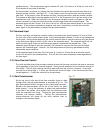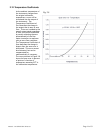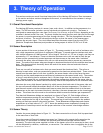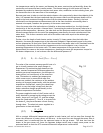
Manual: 151-082010 300-302 Series Page 7 of 31
2. Installation and Operation
This section contains the steps necessary to assist in getting a new flow meter/controller into
operation as quickly and easily as possible. Please read the following thoroughly before attempting to
install the instrument.
2.1. Receiving Inspection
Carefully unpack the Hastings unit and any accessories that have also been ordered. Inspect for any
obvious signs of damage to the shipment. Immediately advise the carrier who delivered the shipment
if any damage is suspected. Check each component shipped with the packing list. Insure that all parts
are present (i.e., flow meter, power supply, cables, etc.). Optional equipment or accessories will be
listed separately on the packing list. There may also be one or more OPT-options on the packing list.
These normally refer to special ranges or special gas calibrations. They may also refer to special
helium leak tests, or high pressure tests. In most cases, these are not separate parts, rather, they are
special options or modifications built into the flow meter.
Quick Start
1. Insure flow circuit mechanical connections are leak free
2. Insure electrical connections are correct (see label).
3. Allow 30 min. to 1 hour for warm-up.
4. Note the flow signal decays toward zero.
5. Run ~20% flow through instrument for 5 minutes.
6. Insure zero flow; wait 2 minutes, then zero the instrument.
7. Instrument is ready for operation
2.2. Power Requirements
The HFM-300 meter requires +15 VDC @ 55 mA, -15 VDC @50 mA for proper operation. The HFC-302
controller requires ±15 VDC @ 150mA. The supply voltage should be sufficiently regulated to no more
than 50 mV ripple. The supply voltage can vary from 14.0 to 16.0 VDC. Surge suppressors are
recommended to prevent power spikes reaching the instrument. The Hastings power supply described
in Section 1.4.2 satisfies these power requirements.
2.3. Output Signal
The standard output of the flow meter is a 0-5 VDC signal proportional to the flow rate. In the
Hastings power supply the output is routed to the display, and is also available at the terminals on the
rear panel. If a Hastings supply is not used, the output is available on pin 6 of the “D” connector. It is
recommended that the load resistance be no less that 2kΩ. If the optional 4-20 mA output is used, the
load impedance must be selected in accordance with Section 1.3.



